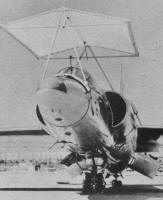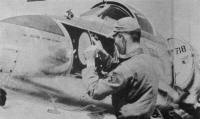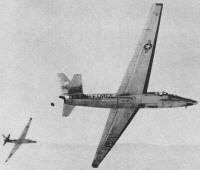|
Most people having any familiarity
with the Lockheed
U-2 spy plane associate it with USAF pilot
Gary Francis
Powers being shot down in it in 1960, over the USSR during the height of the Cold
War. The U-2 first flew on August 1, 1955, and was the product of
 Kelly Johnson's
Skunk Works,
which also produced the SR-71 Blackbird and many other fine aircraft on the bleed edge
of aerospace technology. High altitude reconnaissance was - and still is - the forte
of the U-2, making it a work horse for scientific research as well as its designed purpose
as a human and military intelligence gathering platform. In fact,
NASA still operates a few U-2s today. Kelly Johnson's
Skunk Works,
which also produced the SR-71 Blackbird and many other fine aircraft on the bleed edge
of aerospace technology. High altitude reconnaissance was - and still is - the forte
of the U-2, making it a work horse for scientific research as well as its designed purpose
as a human and military intelligence gathering platform. In fact,
NASA still operates a few U-2s today.
Lockheed U-2 Spy Plane
 Although the U-2 is still discussed in official
circles with restraint, some information has been released recently concerning the craft
and its use. They have been operating from Edwards AFB since 1957 and are used to plot
the course of tornado lines, collect cosmic rays, shoot high-altitude photos of hurricanes
and cloud cover as well as of the Arctic and Antarctic, study high-level turbulence and
jet stream, plus participating in the "Discoverer" satellite program by dropping dummy
payloads to help training in recovery techniques. Although the U-2 is still discussed in official
circles with restraint, some information has been released recently concerning the craft
and its use. They have been operating from Edwards AFB since 1957 and are used to plot
the course of tornado lines, collect cosmic rays, shoot high-altitude photos of hurricanes
and cloud cover as well as of the Arctic and Antarctic, study high-level turbulence and
jet stream, plus participating in the "Discoverer" satellite program by dropping dummy
payloads to help training in recovery techniques.
   A report to Argentina by the Defense Atomic Support
Agency has revealed some data concerning use of the U-2 in HASP (High Altitude Sampling
Program). Basic sampling aircraft for the program is the U-2; six of these are fitted
with a duct in the nose. The pilot opens the nose door allowing ram air to enter the
duct which widens gradually to a 10-in diameter at the filter paper location. The filters
are secured in a ring holder with a wire mesh fore and aft to provide rigidity and to
prevent tearing. Four sample holders are placed in a circular rack by which the filters
may be rotated sequentially into the duct by the pilot. A report to Argentina by the Defense Atomic Support
Agency has revealed some data concerning use of the U-2 in HASP (High Altitude Sampling
Program). Basic sampling aircraft for the program is the U-2; six of these are fitted
with a duct in the nose. The pilot opens the nose door allowing ram air to enter the
duct which widens gradually to a 10-in diameter at the filter paper location. The filters
are secured in a ring holder with a wire mesh fore and aft to provide rigidity and to
prevent tearing. Four sample holders are placed in a circular rack by which the filters
may be rotated sequentially into the duct by the pilot.
  An independent detachable hatch duct has also
been installed. It is similar in design to the nose duct and provides a capacity of 6
additional 16" filter papers. Two of the U-2s have also been fitted with a dust impaction
probe. This sampling probe contains coated electron microscope, grids and/or small glass
slides. The probe is loaded and unloaded in the laboratory and is designed for minimal
contamination during times when it is not exposed to stratospheric air. Exposure is made
during normal HASP missions. An independent detachable hatch duct has also
been installed. It is similar in design to the nose duct and provides a capacity of 6
additional 16" filter papers. Two of the U-2s have also been fitted with a dust impaction
probe. This sampling probe contains coated electron microscope, grids and/or small glass
slides. The probe is loaded and unloaded in the laboratory and is designed for minimal
contamination during times when it is not exposed to stratospheric air. Exposure is made
during normal HASP missions.
 In the past, this specialized aircraft has been
referred to as just U-2, but In the past, this specialized aircraft has been
referred to as just U-2, but
 of late there has been reference to a U-2B and
U-2D, as well as single-seat and two-place versions. Early Lockheeds were powered by
a single 11,000-lb thrust P&W J57; later models are reported to have the more powerful
J75-P-13. Wingspan is 80' 2"; length 49' 8". Forward landing gear is dual pneumatic type,
approximately 20" diameter, is non-steerable; rear gear is dual hard rubber of approximately
8" diameter and steerable. A lightly stressed thin skin covers the U-2. J57 powered U-2
has a 3000-mi range at 475-mph at 70,000-ft altitude and flight endurance of 7 1/2-hr.
Speed is Mach .73 to .80. of late there has been reference to a U-2B and
U-2D, as well as single-seat and two-place versions. Early Lockheeds were powered by
a single 11,000-lb thrust P&W J57; later models are reported to have the more powerful
J75-P-13. Wingspan is 80' 2"; length 49' 8". Forward landing gear is dual pneumatic type,
approximately 20" diameter, is non-steerable; rear gear is dual hard rubber of approximately
8" diameter and steerable. A lightly stressed thin skin covers the U-2. J57 powered U-2
has a 3000-mi range at 475-mph at 70,000-ft altitude and flight endurance of 7 1/2-hr.
Speed is Mach .73 to .80.
Posted May 31, 2014
|